She was one of the most famous military formations of the ancient world. To this day, it stimulates our minds and is an inspiration for pop culture. Fascinating, requiring great strength and discipline. Phalanx - learn about its history.
It is well known that the phalanx is a Greek military formation that has had remarkable military successes. Although so famous, even its very beginnings are shrouded in mystery and still cause discussion among historians.
The existence of this type of formation is evidenced by the Stela of the Vultures, which is currently stored in the Louvre. It is a Sumerian find dating back to around 2400 B.C. It captures the clash between the warriors of the city of Lagash and Umma. The former are presented in dense ranks, wielding spears that protrude between the dense wall of shields.
Hoplite Essentials
The phalanx as a military formation emerged in Greece in the 8th century BCE. Only the elite of the Greek city-states were accepted into its ranks - the hoplites who formed it had to equip themselves with armor . The necessary equipment of the warrior included a round bronze shield, about a meter in diameter.
Another necessary thing was a one-handed spear, 1.8-2.4 meters long, with an iron point at the end. In its lower part it was ended with a skewer, known as the "lizard killer". It was certainly not only meant to kill reptiles. It was used to finish off the wounded and was an element isolating the wooden tree from moisture when the spear was driven into the ground.
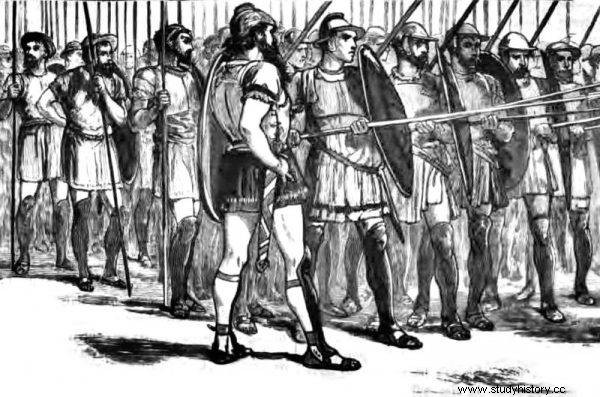
The phalanx as a military formation emerged in Greece in the 8th century BCE. Only the elite of Greek city-states were accepted into its ranks
Another element of the hoplite's equipment was a 30-60 cm long sword. Although necessary in the equipment, the sword was a backup weapon for the warrior, and the Greeks used it only when the spear was no longer usable .
To protect the hoplite, he also wore a breastplate and backplate, greaves and a helmet. Additionally, you could get swords and knives of a different type, but they were no longer a "must have" of the hoplite. The entire armament of one warrior could weigh about 20 kilograms and was extremely valuable to the owner.
Perfect chic
The basis for the success of the phalanx was an inextricable wall of shields that could not even be pressed with a pin. Above the shields only helmets were visible, below - only greaves. This formation required from the soldiers not only enormous strength, but also perfect synchronization.
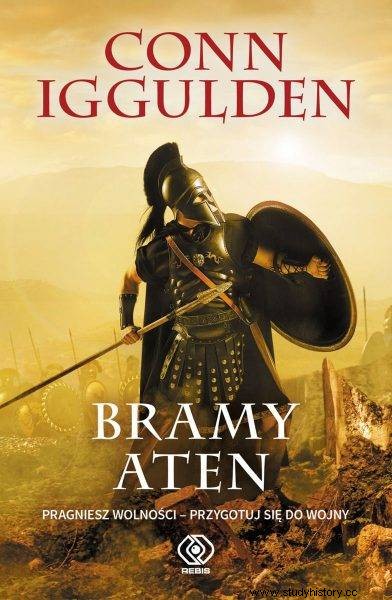
The text is inspired by Conn Iggulden's novel "The Gates of Athens", the first volume of "The Athenian" - a new trilogy by the author of the best-selling novels about Julius Caesar in the series "Imperator" and "Spartan Falcon"!
Weighing about 8 kilograms, the shield had to be held on the left hand outstretched. The representations on black and red figure ceramics indicate that the hoplites did not have any additional support for the shield. The images of the phalanx show them in a position where the shield is distant from the body. Maintaining a compact formation with an eight-kilogram shield extended forward required a warrior of extraordinary condition and endurance.
War evolution
The phalanx in its classic version was a forward-facing formation, leaning against the shield wall. In its basic form, it consisted of 8–16 ranks of hoplites who exchanged when necessary or when their comrades died. However, she had a certain point that was difficult to jump over, and Thucydides had already written about it in the "Peloponnesian War":
It can be seen in any army that when attacking, the right wings tend to move to the right, so that both fighting sides extend their right wings beyond their opponents' left wings. This is due to the fact that each soldier, fearing for the exposed right part of his body, tries to move as close as possible under the neighbor's shield on the right , believing that the compactness of the pattern is the best cover.
This movement begins with the first soldier standing at the very end of the right wing, who wants to move his right part of his body away from his enemies with a bare shield, and follows him, following this fear alone, everyone else follows.
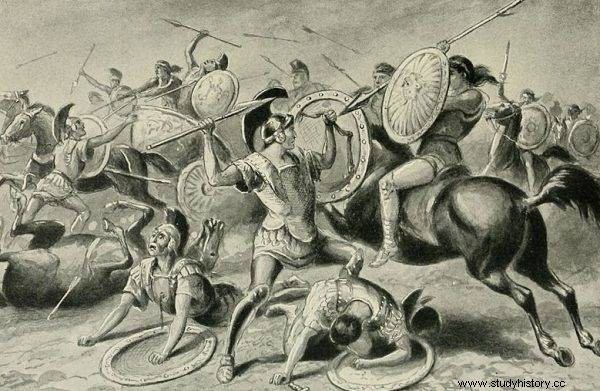
This tactic was first used in the Battle of Leuktrami in 371 BCE. The Theban army then defeated the Spartans despite being outnumbered by the latter.
The first revolution in the phalanx formation was most likely made by Epaminondas, introducing a diagonal formation. As a result, the left wing, reinforced by up to fifty ranks, could weaken the enemy's right wing faster. This tactic was first used in the Battle of Leuktrami in 371 BCE. The Theban army then defeated the Spartans despite being outnumbered by the latter.
Subsequent reforms of the phalanx were due to Iphicrates, who lengthened the spears to 2.5 meters. He thus increased the distance between the enemy armies. Thanks to this, he eliminated the possibility of using swords during the first encounter which until now was to take place in the clash of shields.
This reform, however, had consequences in terms of armaments. A longer spear meant it was necessary to use two hands to fight. Therefore, it was necessary to change the shield to a lighter and smaller one. Swords were also lengthened at that time. The armor and footwear have also been changed.
Macedonian perfection
The culmination of the reforms described above was the Macedonian phalanx. This formation, thanks to subsequent changes in armament, could grow to sixteen ranks.
The spear was lengthened to about 5-6.5 meters and as such was extremely difficult to transport. Archaeological findings suggest that it was stored in two pieces which were then joined before battle with a special metal sleeve.
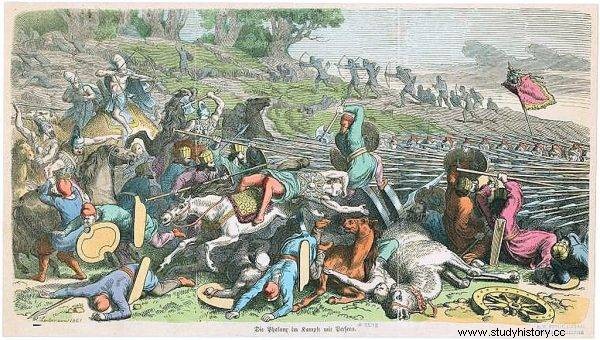
Attacking such a forest of weapons was a suicide mission.
The spears were equipped with a fairly small iron point, which not only relieved the upper part of the weapon, but was also perfect for piercing the enemy's armor. The extension of the primary weapon provided the phalanx with the ability to engage the ranks positioned at the rear. From that moment on, the enemy who had broken through the first line was picking up more spears. An attack on such a forest of weapons was a suicide mission.
Additionally, the soldiers were still armed with swords and armor, which also evolved in their shape. The protective armament still consisted of an armor, a helmet and greaves, and a shallow shield about sixty centimeters in diameter.
The phalanx in practice
This extraordinary military formation was one of the greatest assets of the army. Only the clash with the Roman legions, which introduced a new type of tactics, brought her power to decline. Nevertheless, in its heyday it must have been an extraordinary show of strength, dexterity and timing.
How could a phalanx function on the battlefield look like in practice? The fictionalized image of the fight can be found in Conn Iggulden's book "The Gates of Athens". The author vividly describes the phalanx tactics used in the Battle of Marathon:
- On my signal! Six steps back! Six steps on my signal. Get your spears ready! He yelled over their heads.
In the frenzy of battle, he was hard to hear. Besides, no one wanted to go back now. The people were overwhelmed with a murderous frenzy, taking the lives of the heavily panting Immortals who just a moment ago hoped to be on the verge of breaking through the enemy front.
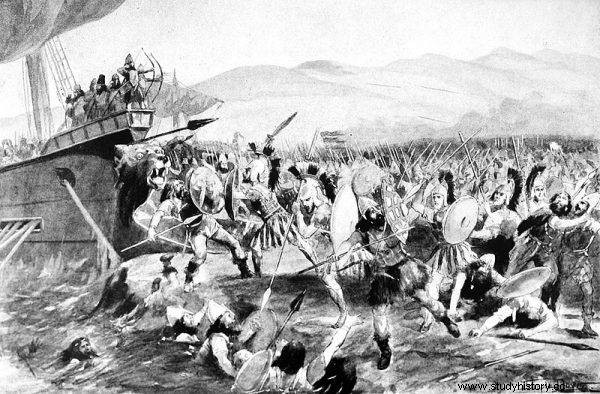
Battle of Marathon
- Six steps ... now!
With a furious howl from their throats, Themistocles' men backed away. The second time the ranks were ranks smoother, no one turned, and all retreating stares stared at the Persians, who were cutting the air in vain with their swords. While Themistocles was counting the steps, the hoplites exchanged. They raised their shields and some managed to reach for spears from the ground.
Literature:
- Thucydides, "The Peloponnesian War", trans. Kazimierz Kumaniecki, Warsaw 1988.
- Cole, "Legion vs. Phalanx. An epic infantry fight of the ancient world “, Poznań 2020.
- Hanson, "Hoplites:The Classical Greek Battle Experience", London 1993.
- Iggulden, "Gates of Athens", Poznań 2021.
